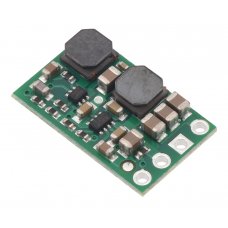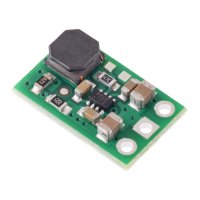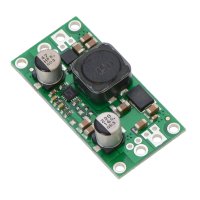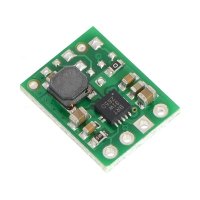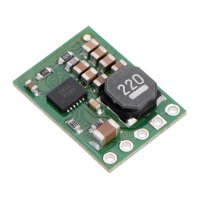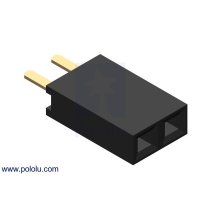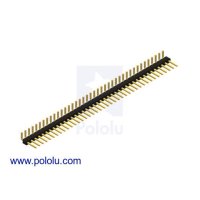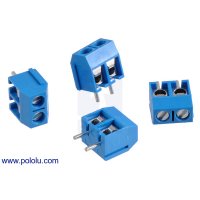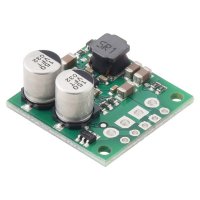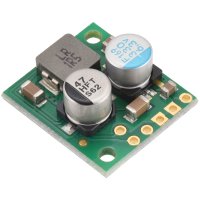This synchronous switching step-up/step-down regulator efficiently produces 3.3 V/ 5 V/6 V/ 7.5 V/ 3.3 V from input voltages between 1.4 V and 16 V. (Note: minimum startup voltage is 2.7 V, but it operates down to 1.4 V after that.) Its ability to convert both higher and lower input voltages makes it useful for applications where the power supply voltage can vary greatly, as with batteries that start above but discharge below 3.3 V/ 5 V/ 6 V/7.5 V/3.3 V. The available output current depends on the input voltage (typically between 1 A and 1.5 A continuous for input voltages close to the output). The regulator also features an optional enable input that can be used to put the regulator in a low-power state with a current draw of less than 15 µA per volt on VIN. The board measures 0.4″ × 0.65″ and has a typical efficiency of 80% to 90%.
Overview:
The S8V9Fx family of efficient switching regulators (also called switched-mode power supplies (SMPS) or DC-to-DC converters) convert both higher and lower input voltages to a regulated output voltage. They take input voltages from 1.4 V to 16 V and increase or decrease them as necessary, offering typical efficiencies of 80% to 90% and typical continuous output currents over 1 A for input voltages close to the output voltage. (Note: The minimum start-up voltage is 2.7 V; see the connections section for details.)
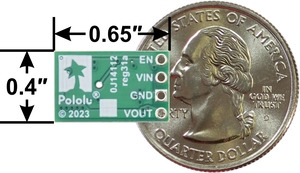
The flexibility in input voltage offered by this family of regulators is especially well-suited for battery-powered applications in which the battery voltage begins above the regulated voltage and drops below as the battery discharges. Without the typical restriction on the battery voltage staying above the required voltage throughout its life, new battery packs and form factors can be considered.
The S8V9Fx regulators have under-voltage lockout and over-current protection. A thermal shutdown feature also helps prevent damage from overheating and a soft-start feature limits the inrush current and gradually ramps the output voltage on startup.
This family consists of five regulators with output voltages ranging from 3.3 V to 9 V:
- S8V9F3: 3.3V output
- S8V9F5: 5V output
- S8V9F6: 6V output
- S8V9F7: 7.5V output
- S8V9F9: 9V output
The different versions of the S8V9Fx regulators all look very similar, so the bottom silkscreen includes a blank space where you can add your own distinguishing marks or labels.

Details for item #4964/4965/4966/4967/4968:
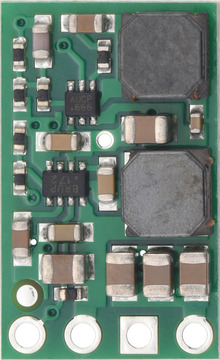
Step-Up/Step-Down Voltage Regulator S8V9Fx, top view.
Features:
- Input voltage: 1.4 V to 16 V (Note: minimum start-up voltage is 2.7 V)
- Output voltage: 3.3 V/5V/6V/7.5V/9V with 4% accuracy
- Typical maximum continuous output current: 1 A to 1.5 A/1A when input voltage is close to the output voltage (see the maximum continuous output current graph below for current capabilities across the full input voltage range)
- Typical efficiency of 80% to 90%, depending on input voltage and load (see the efficiency graph below)
- Under 3/4/5/6/ mA typical no-load quiescent current (see the quiescent current graph below); can be reduced to 10 µA to 15 µA per volt on VIN by disabling the board
- Soft-start feature limits inrush current and gradually ramps output voltage
- Over-current protection and over-temperature shutoff
- Input under-voltage lockout
- Power-saving feature maintains high efficiency at low currents
- Compact size: 0.4″ × 0.65″ × 0.1″ (10.2 mm × 16.5 mm × 2.6 mm); see the dimension diagram for more information
Using the Regulator
Connections
The step-up/step-down regulator has four main connections: the output voltage (VOUT), ground (GND), the input voltage (VIN), and an enable input (EN).
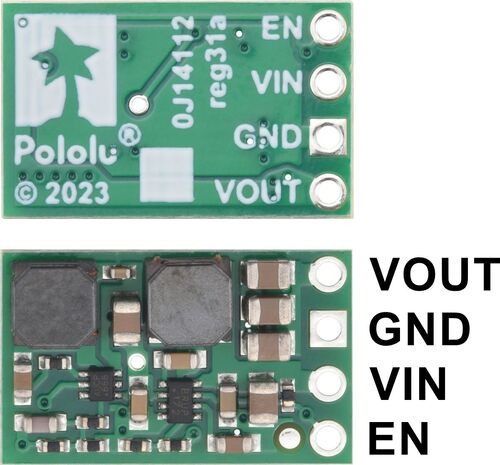
VOUT is the regulated output voltage. The regulator’s soft-start feature gradually ramps up the VOUT voltage on start-up to limit in-rush current draw.
The input voltage, VIN, should be between 2.7 V and 16 V when the regulator is first powered. After the regulator is running, it can continue operating down to 1.4 V. Lower inputs can shut down the voltage regulator; higher inputs can destroy the regulator, so you should ensure that noise on your input is not excessive, and you should be wary of destructive LC spikes (see the LC voltage spike section below for more information).
The regulator, which is enabled by default, can be put into a low-power sleep state by bringing the EN pin low (under 1 V). Leaving the pin disconnected or bringing the pin above 1.3 V will enable the regulator. The quiescent current draw in sleep mode is dominated by the current in the 100 kΩ pull-up resistor from ENABLE to VIN, which altogether will be between 10 µA and 15 µA per volt on VIN.
Included hardware:
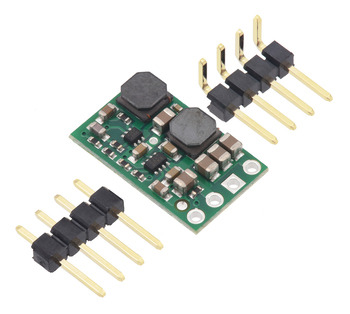
The through-holes are arranged with a 0.1″ spacing along the edge of the board for compatibility with standard solderless breadboards and perfboards and connectors that use a 0.1″ grid. You can solder wires directly to the board or solder in the included breakaway 4×1 straight male header strip or the 4×1 right-angle male header strip as desired.
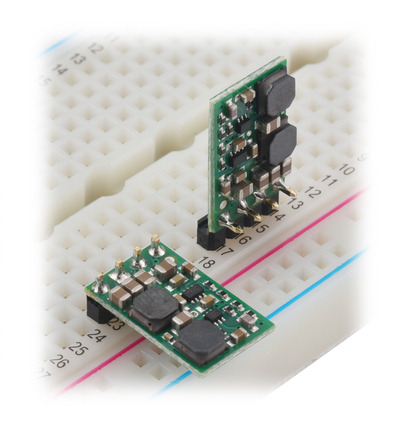
Typical efficiency
The efficiency of a voltage regulator, defined as (Power out)/(Power in), is an important measure of its performance, especially when battery life or heat are concerns.
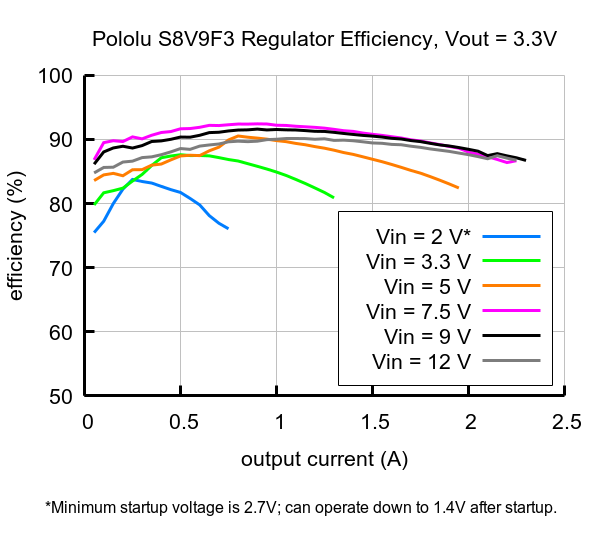
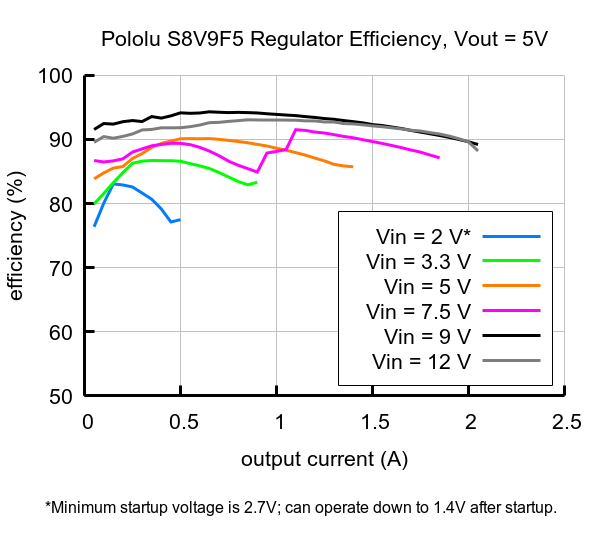
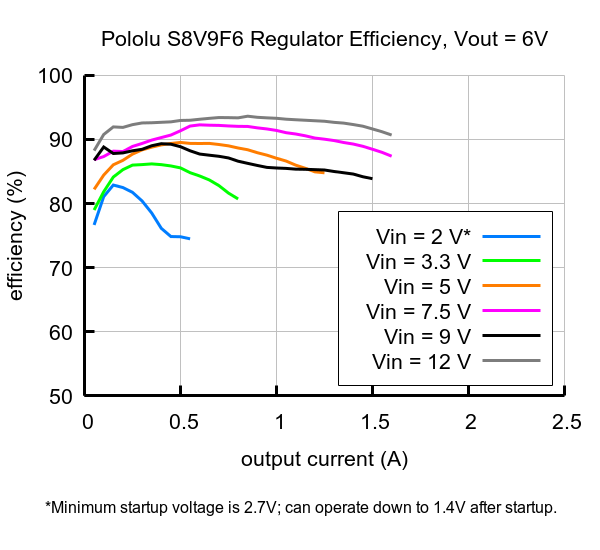
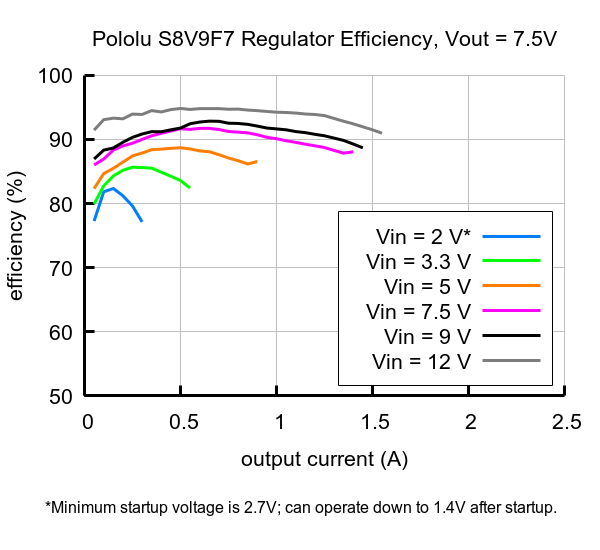
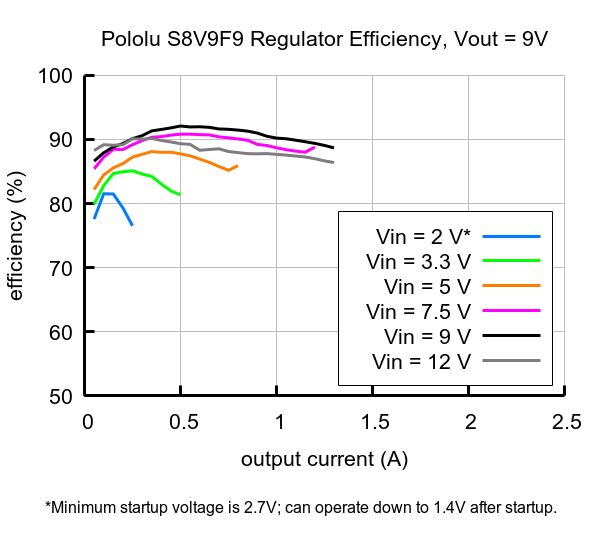
Maximum continuous output current:
The maximum achievable output current of the regulator varies with the input voltage but also depends on other factors, including the ambient temperature, air flow, and heat sinking. The graph below shows maximum output currents that the regulators in the S8V9Fx family can deliver continuously at room temperature in still air and without additional heat sinking.
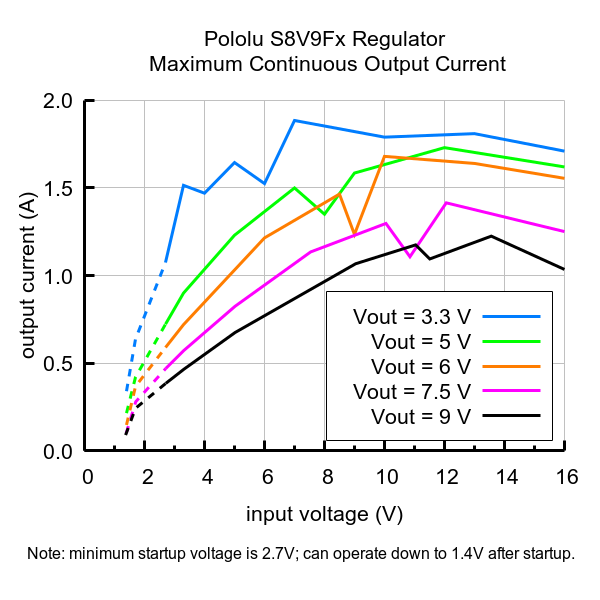
During normal operation, this product can get hot enough to burn you. Take care when handling this product or other components connected to it.
Quiescent current:
The quiescent current is the current the regulator uses just to power itself, and the graph below shows this as a function of the input voltage. The module’s EN input can be driven low to put the board into a low-power state where it typically draws between 10 µA and 15 µA per volt on VIN.
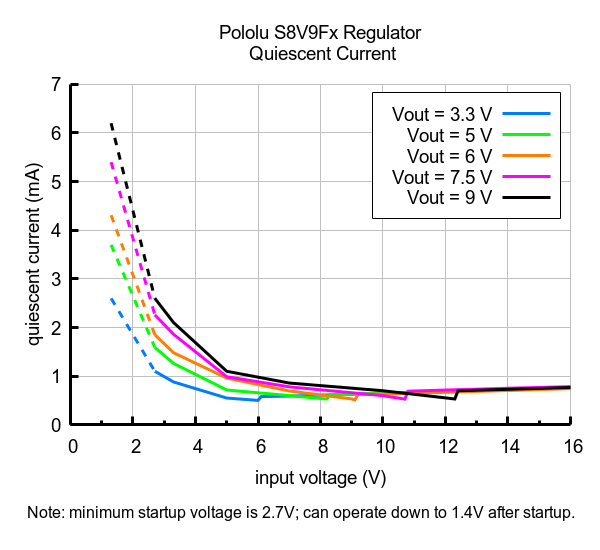
LC Voltage Spikes
When connecting voltage to electronic circuits, the initial rush of current can cause voltage spikes that are much higher than the input voltage. If these spikes exceed a regulator’s maximum voltage, the regulator can be destroyed. If you are connecting more than about 9 V, using power leads more than a few inches long, or using a power supply with high inductance, we recommend soldering a 33 μF or larger electrolytic capacitor close to the regulator between VIN and GND. The capacitor should be rated for at least 20 V.
Package Includes:
- 1 x Pololu 4964/4965/4966/4967/4968 3.3V/5V/6V/7.5V/9V Step-Up/Step-Down Voltage Regulator S8V9F3/F5/F6/F7/F9
Pololu 4964/4965/4966/4967/4968 3.3V/5V/6V/7.5V/9V Step-Up/Step-Down Voltage Regulator S8V9F3/F5/F6/F7/F9
- Brand: Pololu
- Product Code: NR-Pololu-Step-Up-Down-Voltage-Regulator
- Reward Points: 7
- Availability: In Stock
- रo 731.00
-
रo 702.00
- Price in reward points: 731
-
- 25 or more रo 699.00
- 96 or more रo 663.00
Available Options
Related Products
Pololu 4940/4941/4942/4943/4944/4945/4946 Step-Up Voltage Regulator U3V16F3/5/6/7/9/12/15
This compact (0.32″×0.515″) switching step-up (or boost) voltage regulator efficiently generates 3.3..
रo 451.00 रo 470.00
Pololu 2574/2575/2576/2577/2572/2573 5V/ 6V/ 9V/ 12V/ 4-12V/ 9-30V Step-Up/Step-Down Voltage Regulator S18V20F5/ 6/ 9/ 12/ ALV/ AHV
This powerful S18V20F5 S18V20F6 S18V20F9 S18V20F12 step-up/step-down regulator efficiently produces ..
रo 2,092.00 रo 2,179.00
Pololu 2561/2562 3.3/ 5V Step-Up Voltage Regulator U1V11F3/ U1V11F5
This compact (0.45″×0.6″) U1V11F3/ U1V11F5 switching step-up (or boost) voltage regulator efficientl..
रo 527.00 रo 549.00
Pololu 2830 / 2831 / 2832 / 2833 / 2834 1A Step-Down Voltage Regulator D24V10F3/ 5/ 6/ 9/ 12
The compact (0.5″ × 0.7″) D24V10F3/ 5/ 6/ 9/ 12 synchronous buck voltage regulator takes an input vo..
रo 754.00 रo 786.00
Pololu 1012/1013/1014/1015/1016/1017/1018/1019/1020/1021/1030/1031/1111 0.100 inch (2.54 mm) Female Header
These 0.1" straight female header strips are commonly used as low-cost connectors for custom-made ca..
रo 34.00
Pololu 967 / 2668 / 2669 0.100 inch (2.54 mm) Breakaway Male Header: Right Angle
These 0.1″/2.54mm-pitch header strips are commonly used as low-cost connectors. The standard spacing..
रo 133.00 रo 138.00
Pololu 2440/2441/2444/2445 Screw Terminal Block, Side-Entry
These terminal blocks have terminals that hold and release wires through the simple adjustment of a ..
रo 102.00 रo 107.00
Pololu 4980/4981/4982/4983/4984/4985 3.3V/6V/7.5V/9V/12V/15V 2.5A Step-Up/Step-Down Voltage Regulator S13V25F3/F6/F7/F9/F12/F15
This synchronous switching step-up/step-down regulator efficiently produces 3.3 V / 6 V / 7.5 ..
रo 1,057.00 रo 1,101.00
Pololu 4891/4892/4893/4894/4895/4896/4897 3.3V/5V/6V/7.5V/9V/12V/15V Step-Down Voltage Regulator D30V30F3/F5/F6/F7/F9/F12/F15
The D30V30Fx family of buck (step-down) voltage regulators generates lower output voltages from inpu..
रo 969.00 रo 1,101.00

